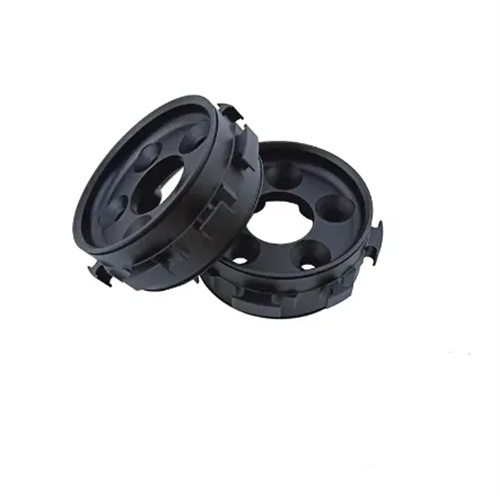Injection molded rib exhaust
Injection molding ribs, a key design element for enhancing the structural strength of plastic parts, are often in the form of narrow strips or grids. These ribs are prone to defects such as bubbles, burning, and insufficient filling during the molding process due to poor venting. The thickness of the ribs is typically 0.5-0.7 times the thickness of the main part wall. This relatively thin structure results in high flow resistance for the plastic melt during filling, and enclosed spaces are easily formed at the corners where the ribs connect to the main part. If gas cannot be discharged in time, it will be compressed and generate high temperatures, causing the plastic to decompose and carbonize, resulting in black scorch marks. For example, the grid-like ribs on a laptop computer case lacked a venting structure. This resulted in numerous bubbles at the base of the ribs during production, reducing the strength of the part and causing breakage after installation.

The design of the rib venting structure must take into account the size and distribution of the ribs. Common venting methods include providing venting grooves at the rib ends, utilizing the parting surface for venting, and creating vent holes in the mold core. The depth of the venting groove must be strictly controlled according to the type of plastic. For plastics with good flowability, such as polyethylene and polypropylene, the venting groove depth should be 0.02-0.03mm. For plastics with poor flowability, such as polycarbonate and polyoxymethylene, the depth can be increased to 0.03-0.05mm, and the width should be 5-10mm to ensure smooth gas discharge. At the corner where the rib connects to the main body, the venting groove can be extended to the main body surface to form an “exhaust channel.” For example, a 15mm-high rib on a plastic appliance part has a 0.03mm-deep and 8mm-wide venting groove along its length at the rib end, connected to the venting groove on the main body parting surface. This improves venting efficiency by 40% and reduces the bubble defect rate from 15% to below 3%.

The mold processing accuracy has a significant impact on the exhaust effect of the reinforcement ribs. The surface roughness of the exhaust grooves needs to be controlled below Ra1.6μm to prevent the plastic melt from entering the exhaust grooves and forming flash due to the rough surface. For complex grid-like reinforcement ribs, an inlay mold structure can be used. Insert gaps are set at the intersection of the ribs for exhaust. The gap width is controlled at 0.03-0.04mm, which ensures smooth exhaust and prevents plastic overflow. For example, the radial reinforcement ribs of a certain car engine hood are equipped with inlay gaps at the intersection of 8 ribs, combined with the end exhaust grooves, which increases the gas exhaust volume by 60%, shortens the filling time by 15 seconds, and effectively solves the problem of rib end burning. In addition, the exhaust grooves need to be cleaned regularly to remove residual plastic debris and oil stains to avoid blockage that affects the exhaust effect.

Optimizing process parameters can aid in rib venting. By adjusting injection speed and pressure, the probability of gas compression can be reduced. For slender ribs, a multi-stage “slow-fast-slow” injection speed strategy is employed. Initially, the base of the rib is filled at a low speed to prevent rapid gas entrainment. In the middle, the main body is filled at an accelerated speed, using melt inertia to propel the gas toward the venting groove. Finally, the end of the rib is filled at a reduced speed to ensure complete gas venting. For example, for a 50mm long rib, adjusting the injection speed from a single 60mm/s to 30mm/s (initial 20% of stroke), 80mm/s (middle 60% of stroke), and 40mm/s (final 20% of stroke), combined with a 10% reduction in holding pressure, can reduce the bubble rate within the rib by 80%. Furthermore, appropriately increasing the mold temperature (for example, from 50°C to 65°C) can reduce the viscosity of the plastic melt, reduce flow resistance, and indirectly improve venting.

Targeted venting solutions are required for special types of ribs. For deep-cavity ribs exceeding 20mm in height, spiral venting grooves can be created along the length of the rib on the mold core. The grooves are 0.04mm deep and spaced 5mm apart. This leverages the spiral propulsion force of the melt flow to propel gas from the bottom to the top vent. For ribs with undercuts, venting channels can be integrated into the core-pulling mechanism. The clearance between the core-pulling slider and the core is set to 0.03mm, which not only meets the core-pulling requirements but also allows for the venting of gas at the undercut. For example, a medical device part with undercut ribs successfully addressed the issue of underfill caused by poor venting at the undercut by creating a 0.03mm venting gap in the core-pulling slider, combined with a venting groove at the end. This approach improved the production yield from 72% to 99%. By combining structural design, mold processing, and process optimization, rib venting issues can be systematically addressed, ensuring consistent part quality.
